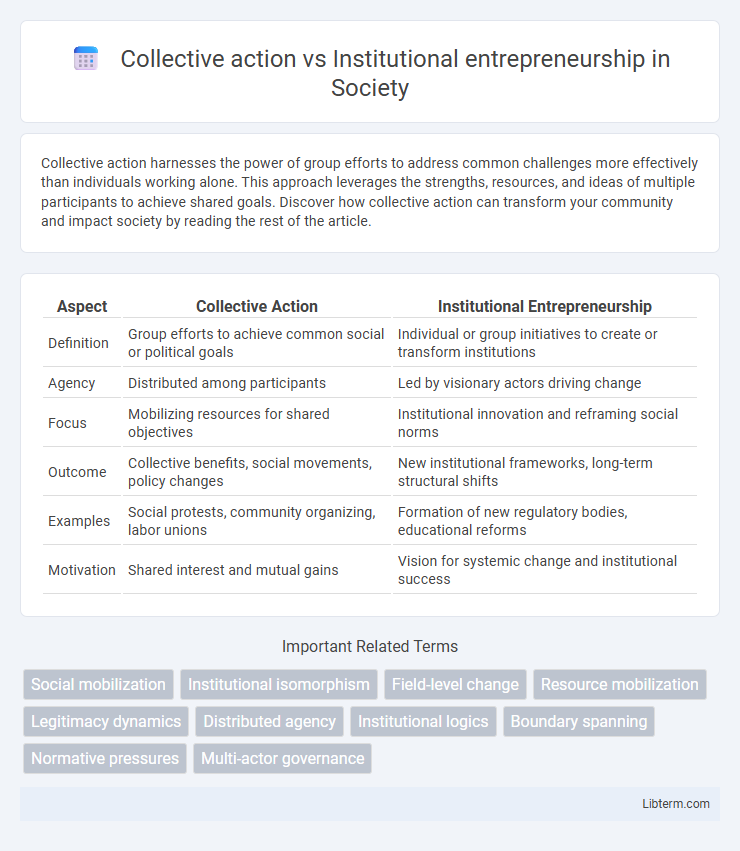Collective action harnesses the power of group efforts to address common challenges more effectively than individuals working alone. This approach leverages the strengths, resources, and ideas of multiple participants to achieve shared goals. Discover how collective action can transform your community and impact society by reading the rest of the article.
Table of Comparison
| Aspect | Collective Action | Institutional Entrepreneurship |
|---|---|---|
| Definition | Group efforts to achieve common social or political goals | Individual or group initiatives to create or transform institutions |
| Agency | Distributed among participants | Led by visionary actors driving change |
| Focus | Mobilizing resources for shared objectives | Institutional innovation and reframing social norms |
| Outcome | Collective benefits, social movements, policy changes | New institutional frameworks, long-term structural shifts |
| Examples | Social protests, community organizing, labor unions | Formation of new regulatory bodies, educational reforms |
| Motivation | Shared interest and mutual gains | Vision for systemic change and institutional success |
Introduction to Collective Action and Institutional Entrepreneurship
Collective action involves groups working together to achieve common goals by overcoming individual self-interest and coordinating efforts for shared benefits. Institutional entrepreneurship refers to the activities of actors who leverage resources and strategic actions to create, transform, or disrupt institutions and social norms. Understanding these concepts highlights the distinct mechanisms of collaboration and innovation essential for social and organizational change.
Defining Collective Action
Collective action refers to the coordinated efforts of a group aiming to achieve a common interest or goal that individual members cannot accomplish alone, often addressing public goods or shared resources. This phenomenon involves shared objectives, mutual interdependence, and mechanisms for managing cooperation and conflict within the group. Understanding collective action is crucial for analyzing social movements, resource management, and community-driven initiatives where collective decision-making and collaboration are key.
What Is Institutional Entrepreneurship?
Institutional entrepreneurship refers to the activities of individuals or groups who leverage resources and authority to create, transform, or disrupt established institutions and social norms. Unlike collective action, which relies on coordinated efforts among multiple actors to achieve a common goal, institutional entrepreneurship emphasizes strategic agency in driving institutional change from within or outside existing structures. Key examples include corporate leaders advocating for regulatory reforms or activists pioneering new social movements that reshape institutional landscapes.
Key Differences Between Collective Action and Institutional Entrepreneurship
Collective action involves coordinated efforts by a group to achieve common goals, relying on shared interests and collaboration, whereas institutional entrepreneurship refers to individuals or entities actively creating or transforming institutional structures and norms. Collective action primarily addresses immediate issues through joint effort, while institutional entrepreneurship focuses on innovation and long-term change within organizational or societal frameworks. The key difference lies in collective action being driven by group dynamics, whereas institutional entrepreneurship centers on proactive, strategic agency to shape institutional environments.
Motivations Behind Collective Action and Institutional Entrepreneurship
Motivations behind collective action often stem from shared goals and the pursuit of common interests to address social dilemmas or public goods challenges. Institutional entrepreneurship is driven by individuals or groups seeking to create, transform, or disrupt institutional norms to gain competitive advantage or social recognition. Both dynamics are fueled by strategic incentives, but collective action emphasizes collective benefits while institutional entrepreneurship focuses on innovation within institutional frameworks.
Processes and Mechanisms Involved
Collective action involves coordinated efforts among individuals or groups to achieve a common goal, primarily relying on mechanisms such as trust-building, communication networks, and shared incentives to overcome collective dilemmas. Institutional entrepreneurship, by contrast, centers on actors who leverage resources, agency, and strategic institutional work to initiate and drive transformative changes within established institutional frameworks. Processes in collective action emphasize consensus and cooperation dynamics, while institutional entrepreneurship focuses on innovation, power mobilization, and redefining rules and norms within organizational fields.
The Role of Leadership and Agency
Leadership in collective action mobilizes group resources and aligns participant interests to achieve common goals, emphasizing shared agency and distributed influence. Institutional entrepreneurship involves proactive leaders who leverage individual agency to disrupt or create institutions, driving systemic change through strategic vision and resource orchestration. Both phenomena highlight leadership's pivotal role in harnessing agency, yet institutional entrepreneurs uniquely navigate and reshape institutional frameworks to sustain long-term innovation.
Outcomes and Impact on Institutions
Collective action often leads to incremental institutional changes by mobilizing groups to address common interests, resulting in strengthened norms and shared governance structures. Institutional entrepreneurship drives transformative outcomes through visionary actors who leverage resources and strategies to reshape or create institutions fundamentally. The impact of collective action stabilizes and reinforces existing institutional frameworks, while institutional entrepreneurship fosters innovation and paradigm shifts within institutional fields.
Case Studies: Real-World Examples
Collective action often appears in environmental movements like the Chipko movement in India, where community members collectively protected forests through local cooperation. Institutional entrepreneurship is evident in the rise of Tesla, where Elon Musk redefined the electric vehicle industry by mobilizing resources to challenge established automotive norms. Both approaches demonstrate how coordinated efforts and innovative leadership can drive significant social and organizational change.
Future Directions and Research Opportunities
Future research on collective action and institutional entrepreneurship should explore the interplay between digital technologies and social movements, analyzing how online platforms catalyze coordinated efforts and innovative institutional changes. Investigating cross-sector collaborations offers opportunities to understand how diverse stakeholders co-create sustainable solutions within institutional frameworks. Emphasizing longitudinal studies can reveal the long-term impacts and evolutionary dynamics of collective action and entrepreneurial initiatives in reshaping institutional norms.
Collective action Infographic

 libterm.com
libterm.com